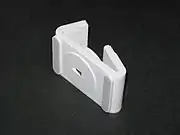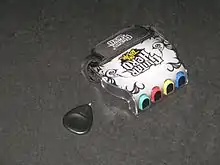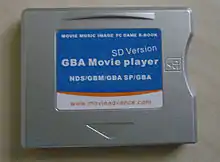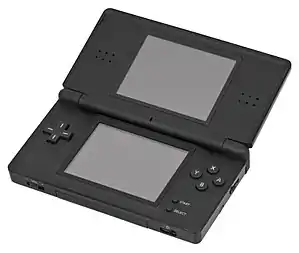List of Nintendo DS accessories
This is a list of Nintendo DS accessories.
Official accessories

Although the secondary port on the Nintendo DS does accept and support Game Boy Advance cartridges (but not Game Boy Color or original Game Boy cartridges), Nintendo has emphasized that its main intention for its inclusion was to allow a wide variety of accessories to be released for the system, the Game Boy Advance compatibility titles being a logical extension.
Rumble Pak
The Rumble Pak was the first official expansion slot accessory. In the form of a Game Boy Advance cartridge, the Rumble Pak vibrates to reflect the action in compatible games, such as when the player bumps into an obstacle or loses a life. It was released on October 24, 2005 and bundled with Metroid Prime Pinball. It can be used in games such as Mario & Luigi: Partners in Time, Star Fox Command, Metroid Prime Hunters, Iron Man, Diddy Kong Racing DS, and Clubhouse Games and is sold as a separate accessory. (For complete list of compatible games to the Rumble Pak, refer to the main link above.)[1] A specially designed Rumble Pak was released in Japan in late May 2006 for the Nintendo DS Lite[2] The cartridge is about 1 cm shorter to prevent it from protruding out of the Nintendo DS Lite as standard Game Boy Advance cartridges do. A North American version of the accessory was released following the June 11, 2006 release of the system. However, it is not compatible with the DSi, DSi XL, or any 3DS because none are equipped with a GBA slot.
Headset
The Nintendo DS Headset is the official headset for the Nintendo DS. It plugs into the headset port (which is a combination of a standard 3.5mm (1/8 inch) headphone connector and a proprietary microphone connector) on the bottom of the system. It features one earphone and a microphone, and is compatible with all games that use the internal microphone. It was released in Japan on September 14, 2006.[39] The headset was released in North America on April 22, 2007, alongside Pokémon Diamond and Pearl, two games that have built-in voice chat. It was later released in Australia on June 21, 2007, also alongside Pokémon Diamond and Pearl. Other communication headsets not made by Nintendo also work as the mic.
Opera Web Browser
On February 15, 2006, Nintendo announced a version of Opera,[3] a cross-platform web browser, which took advantage of the dual screens for either zooming in on certain sections of a website or having a longer vertical view.[4] The browser went on sale in Japan on July 24, 2006, for ¥3,800[5] (approx. $33). It was released in Europe on October 6, 2006.[6]
Memory Expansion Pak
The Nintendo DS Browser ships with an 8 MB RAM pack which fits into the accessory slot, and which is required for the browser to run. Two versions of the Memory Expansion Pak are available. One is compatible with both the original DS and DS Lite, although the cartridge sticks out of the DS Lite. The second is a smaller translucent version which fits flush with the body of the DS Lite, but it can be used in the original DS if modified. The Expansion Pak is not used by any other commercial software, but some homebrew applications such as MoonShell can use it.
Faceningscan
The Faceninscan is a camera that plugs into the GBA slot of the DS. It is included with Face Training, and gives the player a view of their face as they use the game.[7] It is only available in Japan. Another Japan-only game by Sega called 'Shiseido Beauty Solution Kaihatsu Center Kanshuu: Project Beauty' also used the camera attachment.[8]
Slide Controller

Launched only in Japan on August 3, 2007, the Slide Controller is bundled with the game Slide Adventure MAGKID. The Mag Kid is a little magnet that stays all of the time in the center of the touchscreen. The Slide Controller is attached to Slot 2, of the DS, which makes use of the technology of a computer's optical mouse, being that the pak emits red light from a LED light located at the bottom of the controller. In order to move the Mag Kid across the screen during the game, the player has to slide the whole Nintendo DS system with this controller (combined with a slant angle) on a table surface, thus given the name "Slide Controller". The slide controller also has built in rumble features used in the game.
Nintendo DS Digital TV Tuner
The Nintendo DS Digital TV Tuner (ワンセグ受信アダプタ DSテレビ, Wansegu Jushin Adaputa Dī Esu Terebi) is a 1seg TV tuner that picks up TV signals and plays them on the Nintendo DS. The prototypes Nintendo had at the press conference were running via the Game Boy Advance cartridge slot, but the final version plugs into the DS card slot complete with TV aerials that unfold when in use. It was released on November 23, 2007. The top screen is for watching the broadcast in 16:9 or 4:3 ratio. The touch screen is used to change the channels. Not much information is available on the product. It was available in Japan only because it only picks up 1seg broadcast signals. Sold at an online Nintendo shop in Japan. It works with all DS and 3DS models.
Activity Meter
The activity meter is a pedometer included with Personal Trainer: Walking (also named "Walk With Me"). It communicates with the DS using an infra-red transceiver built into the top of the Meter and one in the end of the game cartridge, meaning it works with all DS consoles. Its only display is an LED which changes its colour and flashing pattern once the user reaches their daily step goal; all other information has to be viewed by transferring it to the Nintendo DS cartridge. The device stores the last 7 days of detailed activity statistics, and the last 60 days of total step counts. There is a clip built into the Meter's battery door allowing it to be attached to a person's clothes or a dog's collar; a flat battery door without the clip is also included. The Meter was available in various colours to allow them to be distinguished.
Pokéwalker

The Pokéwalker (ポケウォーカー, Pokewōkā) is a Poké Ball-shaped pedometer which can connect to Pokémon HeartGold and SoulSilver game cards via infrared signals. The player can transfer a Pokémon to the Pokéwalker from either HeartGold or SoulSilver. Every time the player takes a step, the Pokémon inside gains experience points and the player earns "Watts", a type of in-game currency which was also used on the Pokémon Pikachu virtual pet. Players can also catch various Pokémon on the device and obtain items, then transfer them to the game. The device comes bundled with the games.[9][10][11]
When players transfer a Pokémon from their game into their Pokéwalker, they can select which route they would like to take their Pokémon along. Depending on which route the player takes (such as in a grassland or by the sea), they will encounter different wild Pokémon and items. When players first begin their journeys with the Pokéwalker, the list of routes they can select from is short. But, the more players take a stroll with their Pokémon, the more routes will appear and the more Pokémon and items they will be able to get.
One criticism of the Pokéwalker is the ease of "cheating" or "hacking" in which players will intentionally create artificial situations mimicking walking. This has consequently led to multiple varieties of Pokéwalker cheats causing Pokémon to gain experience without the user actually expending any effort.[12]
Due to its efficient accuracy when compared to some other pedometers,[13] the Pokéwalker's technical design had since been reused to work for other titles, such as Wii Fit U, which is compatible with the Fit Meter pedometer, an accessory which even physically looks similar to the Pokéwalker and contains the exact same hardware.
Wireless Keyboard
Released with Learn with Pokémon: Typing Adventure this wireless Bluetooth keyboard was for learning how to type quickly and accurately. The keyboard can be put into a "pairing" mode by holding "Fn" while switching it on and connect with other hardware, including the Wii console.
Calligraphy Brush
DS Bimoji Training includes a "brush" - really just a long stylus - as it's almost impossible to use a normal DS stylus to play this edutainment game.
Third party accessories
Guitar grip controller

The Guitar grip controller comes packaged with the game Guitar Hero: On Tour and is plugged into the GBA game slot. It features four colored buttons just like the ones that can be found on regular Guitar Hero guitar controllers for the stationary consoles, though it lacks the fifth orange button found on the guitar controllers. The DS Guitar Hero controller comes with a small plectrum-stylus that can be put away into a small slot on the controller. It also features a hand strap. The controller comes with two adapters, one for the DS Lite, and one for the original DS. The grip is required in order to play any of the Guitar Hero: On Tour games, and is also used to play Band Hero for the DS.
Band Hero DS drum grip
The Band Hero DS drum grip is a piece of rubberized silicon that slips over a DS Lite, is designed to better enable the feel of rapidly playing the drums than tapping on drum icons on the DS' touch screen, and it's easier on the thumbs than using the buttons.
Paddle controller

Manufactured by Taito, the paddle controller was available only in Japan. It was sold both as a standalone and bundled with Arkanoid. The paddle controller is a miniature version of the arcade knob controllers first made popular with Pong.
Supported titles:
Despite being available only in Japan, the paddle controller is compatible with versions of the above titles from any region.[14]
Motion Pack
Tony Hawk's Motion uses a motion-sensing peripheral called the "Motion Pack", which is inserted into the Game Boy Advance game slot as the method of control.
Didget glucose system
A blood glucose meter developed by Bayer HealthCare together with Paul Wessel, father of a child with diabetes mellitus. This is essentially an upgraded version of the Glucoboy for the Game Boy Advance, which Wessel developed for his son Luke who often lost his blood glucose meter, and later founded his own company, Guidance Interactive Healthcare to pursue the creation of children’s blood glucose meters. The peripheral came with a pack-in game entitled Knock Em Downs Worlds Fair developed by Sensory Sweep Studios, which is a series of minigames where players are rewarded with bonuses and power-ups should they regularly check their blood sugar levels.[15]
Card Reader
Manufactured by Sega, this card reader was available only in Japan. It was sold only with a compatible game. It allows players to scan cards.
Supported titles:
- Oshare Majo Love and Berry: DS Collection
- Kouchuu Ouja Mushiking Super Collection
- Card de Asobu! Hajimete no DS
Piano Keyboard
Easy Piano includes a 13 key piano that attaches to the DS through the Game Boy Advance game slot.[16]
Supported titles:
- Easy Piano
Hacking and Homebrew
DS Brut
DS Brut is an open-source hardware prototyping platform for the Nintendo DS, developed by and for electronics enthusiasts, artists and game developers. By connecting the Nintendo DS to the outer world with UART, GPIO, PWM, ADC, I²C, etc., the game console can be easily hooked up to a variety of sensors (e.g. GPS receivers) and can itself control all different kinds of actuators, servo motors and others.
DS Bluetooth adapter
DS Bluetooth adapter is a tiny Slot-1 cartridge that allows the Nintendo DS to hook up wirelessly with other devices such as GPS-receivers, robots and so forth.
DSRobot
DSRobot turns a Nintendo DS into a fully functional robot with 20 digital input/outputs, customizable motors and sensors, and wireless programming and control. It is programmable in C or C++ with devkitpro and a custom library to manage the signals.
Max Media Dock
Datel manufactures the Max Media Dock, this allows you to access, store and run media content from CompactFlash cards. It can accept cards up to 8 GB in size. This tool also lets people use DS homebrew. DS homebrew is software written for the Nintendo DS handheld games console by hobbyist programmers.
Max Media Dock is compatible with both the original Nintendo DS and the Nintendo DS Lite.
Flash Cartridges
A device used for running software on the DS not hard-encoded into a cartridge, such as homebrew games, homebrew software, listening to music, viewing pictures or documents, other not-officially available functions, and virtual versions of the software on official cartridges; often stored on removable media such as an SD card. There are many DS flash cart variants on the market. Although they are still compatible with the DS, Slot-2 flash carts originally intended for the Game Boy Advance have been superseded by more modern DS flash cards which use slot-1, such as the N-Card, M3, Supercard, EZFlash Vi, G6DS Real, DSTT, Nintendo DS storage devices R4i gold 3ds, Acekard, and CycloDS Evolution.
DS Motion Card
The DS Motion Card and DS Motion Pak are motion sensors for the DS and DS Lite handheld gaming systems. They each contain a 3-axis accelerometer and a single-axis gyroscope, and plug into the DS to enable full motion sensing on the DS and the DS lite. This will work with Mario Kart DS if the Action Replay code is used.
They are the first tri-axis accelerometers that can be used for homebrew DS development, and the first accelerometer/gyroscope combinations available for handheld gaming.
DSMem
The DSMem is an adapter for the Nintendo DS produced by the engineer amadeus in his spare time, aiming to supply the DS with a means of rewriteable storage, and to free some of the DS's 4MB of available memory by using userspace XIP on the binaries contained within the internal flash memory. Over the last months, since the project's announcement on the DSLinux forums at 10:36 on 21 July 2005, the device has evolved from a plan into a fully working prototype. It is to provide an RS-232 interface, Flash memory, and a microSD port. The Linux kernel and uBoot bootloader will be stored in the Flash, while other data are to be stored on the microSD cards. The DS has only limited battery power, so low-power parts must be used. This influenced the decision to use the microSD card, Xilinx Coolrunner II CPLDs, and Intel P30 flash memory, with an LM3670 voltage switcher.
FlashMe
One of the most prevalent booting tools is the program FlashMe. This is a modified firmware for the DS. It is used in many DS devices including the R4, M3, and DSTT card.[17]
GBA Movie Player

Plays films and music from flash memory cards.[18][19][20] Comes in SD and CF versions.
PassMe
After the first passthru (patching card information) got homebrew code running, several people started to produce and sell the so-called PassMe devices. Currently, the BIOS of the Nintendo DS has been disassembled and will lead to passthrules cards. PassMe v1 could simply use any Nintendo DS Game Card to operate, while PassMe v2 required on-board memory for game specific booting, which would combat with later versions of the Nintendo DS's firmware that blocked nongame-specific boots. However, this required SRAM in the media that the PassMe was booting to, and thus did not operate with some media devices, such as the Game Boy Advance Media Player (CF/SD).
NoPass devices
Datel has introduced to the market the first of the aforesaide passthrules cards, dubbed "NoPass" by the homebrewing community.[21] It functions similarly to a PassMe, and unlike previous generations, does not need an official game card or an SRAM-enabled storage device. This opens up the option of using the Game Boy Advance Movie Player with newer-firmware Nintendo DSs.
Trainer Toolkit

A device which fits into the GBA slot on a DS. It must be used in combination with an Action Replay DS. The trainer toolkit is connected to a PC via a mini-USB cable where software can be used to produce a dump of the DS's RAM. The software also provides means to analyse the dump for example to search for specific values, changing or static values. Through this process locations for specific values can be found, commonly health, ammo or time. These can be altered by the action replay code language to create custom cheats. It also provides basic action replay functionality allowing the user to test codes they create.
Wi-Fi
Ever since the Nintendo DS's release on November 21, 2004, several groups have been attempting to extend and build upon the Nintendo DS Wi-Fi protocol. Darkain was leading the reverse-engineering of the Nintendo DS Wi-Fi and Ni-Fi protocols at the time the Nintendo DS came out, which has influenced many of the available Nintendo DS Wi-Fi hacks and applications today.
Two groups (Project Nitro[22] and Team Xlink[23]) had claimed to be successful in tunneling the Nintendo DS WiFi protocol over the internet creating online multiplayer possibilities around the world using the handheld and multiplayer-enabled Nintendo DS games.
However, Project Nitro never put out any software or evidence to support their claim, and has since completely disappeared (the developers moved on to create DSmeet,[24] a place to meet other NDS WiFi users). Team XLink claimed to have a workable system, but later publicly announced they were no longer working on tunneling the Nintendo DS, saying they were not making enough progress to warrant their continued efforts.
In both cases, it is all but certain there was never any tangible product created.
Recently a new project entitled DSTunnel[25] has come into being. It is a culmination of a hacker's work in reverse engineering the DS's Wi-Fi hardware. While it has shown promise, and a beta version has shown some success, it still has the requirement of the user having a RAlink RT2500[26] based Wi-Fi card for it to work.
Since early to mid 2006, Nintendo DS developers have been able to create working Wi-Fi applications through the use of Stephen Stair's NDS Wi-Fi Library. Through modifications of this library, people such as Bronto, of NDSMail, have created functional Wi-Fi apps. DSLinux has also employed Wi-Fi in their port of the Linux operating system. (See below)
Linux
There is currently an ongoing project aiming to bring the Linux operating system to the Nintendo DS, "DSLinux".[27] As of February 2006, this project has successfully executed a 2.6 kernel, the retawq text-only web browser, simple shell, Telnet, SSH, telnetd, some text-based games, touchscreen support, sound (beta) and Wi-Fi support.
Voice over IP
Using the built-in microphone and Wi-Fi connection, developers have recently begun to create Voice over IP applications, effectively turning the Nintendo DS into a WiFi phone. Only DS-to-DS calls were possible, and now support for SIP has been implemented in the form of SvSIP. In conjunction with a SIP provider, it allows you to make phone calls to anyone using the DS whenever there is Wi-FI available.
Cyber Famulator Lite
Cyber Famulator Lite is an addon for the Nintendo DS Lite which allows users to play Famicom games, and NES games with a converter.
NDS Adaptor Plus
NDS Adaptor Plus is a NDS Slot-1 flash cartridge read/write USB adaptor that allows users to back up game ROM and SAV files from the NDS game card to a computer.
References
- "Nintendo Online Store". Retrieved 2006-04-02.
- "Nintendo Japan Product Page". Archived from the original on 2006-04-05. Retrieved 2006-06-14.
- "Giving gamers two windows to the Web: The Opera Browser for Nintendo DS" (Press release). Opera Software. February 15, 2006. Archived from the original on September 9, 2012. Retrieved 2006-04-02.
- Hanson, Berit (2006-02-16). "Opera for Nintendo DS". Berit's Blog. Retrieved 2006-07-03.
- "Mark your calendars: Opera announces Nintendo DS browser release date in Japan" (Press release). Opera Software ASA. 2006-06-21. Archived from the original on 2006-07-02. Retrieved 2006-06-21.
- Chris Playo. "Japan: Nintendo DS Press Conference". NintendoDS Advanced. Archived from the original on 2009-05-16. Retrieved 2006-04-02.
- "Official Nintendo Magazine (UK) confirmation page". Archived from the original on 2007-08-18. Retrieved 2007-07-04.
- http://www.gamefaqs.com/ds/952145-shiseido-beauty-solution-kaihatsu-center-kanshuu/images/box-110159
- Ashcraft, Brain. "Kotaku - Pokemon Heart Gold/Soul Silver Come With Pedometer -Ds". Kotaku. Retrieved 2009-06-08.
- "Take a Stroll with the New Pokéwalker". Pokémon Company International. Retrieved 10 March 2010.
- Tanaka, John (2009-06-08). "Get Fit with Pokemon". IGN. Retrieved 2009-08-08.
- "Top 6 hilarious ways to avoid exercise with the Pokewalker". The Kartel. 2010-04-05. Retrieved 2011-11-08.
- Good, Owen (2011-04-15). "Pokéwalker More Accurate than Other Pedometers in University Study". Kotaku. Retrieved 2014-06-09.
- "Essential Extras: Taito's paddle controller". Archived from the original on 2009-02-06. Retrieved 2009-05-11.
- Stevens, Tim. "Bayer Didget blood glucose monitoring system does double-duty as a DS game". Engadget. Retrieved 24 August 2018.
- "Easy Piano for Nintendo DS shipping now for little Tchaikovskys". Engadget. Retrieved 2020-07-24.
- "General Information About Nintendo DS and R4 Cards". Archived from the original on 2011-02-03. Retrieved 2010-06-27.
- http://www.nintendoworldreport.com/review/4180/gba-movie-player-game-boy-advance
- http://www.shacknews.com/article/30374/late-night-consoling-ex-gba
- https://www.engadget.com/2006/07/06/ds-fanboy-vs-gba-movie-player/
- "Max Media Launcher". Code Junkies. Archived from the original on 2007-10-14. Retrieved 2006-05-21.
- "Nintendo DS Online (Nitro Online)". SourceForge. Retrieved 2006-04-03.
- "XLink Kai". Retrieved 2006-04-03.
- "DS Meet". Archived from the original on 2005-11-30. Retrieved 2017-01-26.
- "dstunnel: Wifi Tunnelling for Nintendo DS Multiplayer". Retrieved 2006-04-03.
- "Products - RT2500 Chipset Solution". Archived from the original on 2006-04-07. Retrieved 2006-04-03.
- "DSLinux : The home of Linux on the DS". Retrieved 2006-04-03.

